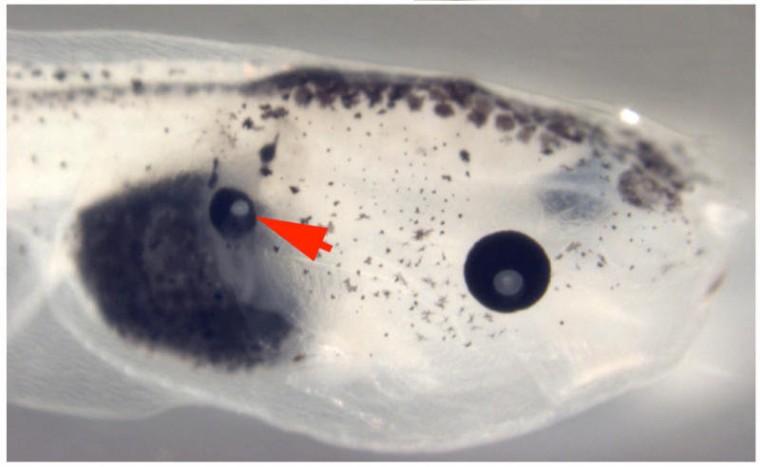The photo above is the product of my imagination running a little wild, but as an enthusiastic science spectator, I reserve the right to allow my mind to drift to fantasy when the actual science is so spectacular.
In this case, the spectacular science news is that researchers were able to grow eyes on a frog (a tadpole actually) in places on its body that don't usually grow eyes.
Being dazzled by regenerative medicine is not really new. Think of all the amazing things we've read about what can be done with stem cells. But I think the popular perception of stem cells is that they work by magic. How else would these undefined cells suddenly know what to grow into? Now, I'm not saying it's not magic, but if you want to know more specifically about how the spell is cast, the answer turns out to have to do with membrane voltage.

Scientists looked at how organs developed in growing tadpoles and also planarian flatworms, which are able to regenerate limbs. What they saw was different voltage associated with different organs.
So they looked at what would happen if they disrupted that voltage and sure enough, they got malformations. Researchers also figured out how to immitate the process to re-grow things that don't usually regrow (like a tadpole's tail after a certain point of development).
The new news is that they've gone so far as to use the technique to grow an organ where it doesn't usually grow.
"By using a specific membrane voltage, we were able to generate normal eyes in regions that were never thought to be able to form eyes. This suggests that cells from anywhere in the body can be driven to form an eye."
All this talk of voltage and cell electricity calls to mind images of Frankenstein and curly-wired electrodes attached to brains in jars, but that too is more for the fictionalized comic book version. What they really do is manipulate special proteins that allow charged particles into the cell. In this case, very early in the tadpole's development they introduced the means of changing a cell's membrane voltage. Eventually, through the course of the tadpole's growth, the affected cells turned up in different parts of the tadpole. In cases where the right cells ended up with the right voltage, the voltage triggered the cell's DNA to for the cell to grow into an eye, and the next thing you know you've got an eye on your back -- or something like that.
The full paper is not available for free, but I suspect the details would be over my head anyway. Senior and corresponding author of the paper, Dr. Michael Levin, however, has a bit more on the subject on his site if you're interested, and it's not impossibly technical.
Lastly, there's no better way to rain on the parade of an exciting science story than by reading the online forum discussions about it. People in this field of research see different news in this study than those of us who haven't been paying attention. The role of ions in regeneration is already known to scientists, as is the means through which those ions are channeled into cells. But for those of us who haven't been paying attention, holy crap! They grew an eye on a tadpole's back!
Any insights you have on when the science fiction and science fact of regenerative medicine will come into closer alignment are very welcome in the comments.
